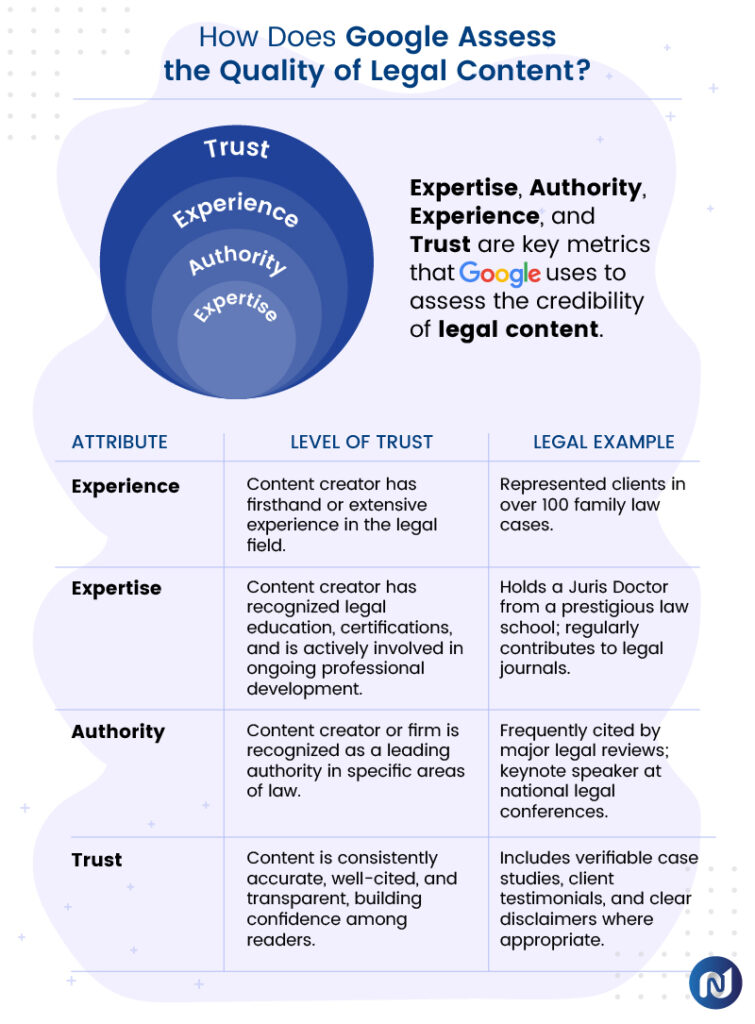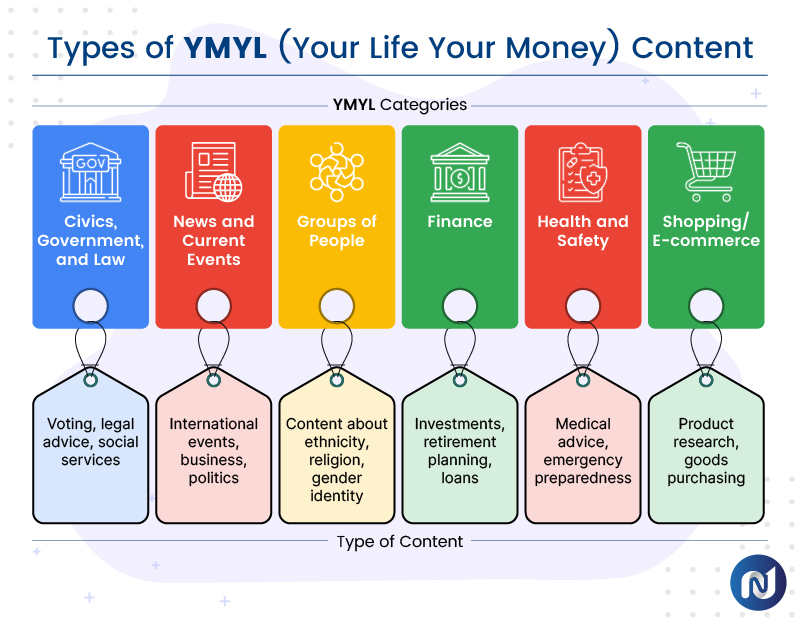
As a lawyer, you know how important it is to establish your firm as a trusted authority in the Canadian legal landscape. One effective way to do this is by creating thought leadership content that resonates with your target audience and boosts your SEO. Our previous article discussed how thought leadership content can boost SEO for law firms. Let’s learn the nitty-gritty of creating content that drives traffic, builds credibility, and positions your law firm as a go-to resource for Canadian legal expertise.
Table of Content
Understanding E-E-A-T and YMYL in the Context of Law Firm Content
Google’s algorithms prioritize E-E-A-T (Experience, Expertise, Authoritativeness, and Trustworthiness) to evaluate content, with a particular focus on YMYL (Your Money or Your Life) topics due to their potential to significantly impact a reader’s health, finances, and safety. Meeting these criteria is critical in the legal sector, where advice directly affects legal outcomes and financial stability.
E-E-A-T in Law Firm Content
Here is how each aspect of Google’s E-E-A-T framework can be effectively demonstrated in your law firm’s content.
- Experience: Showcasing your firm’s history of successful case outcomes or long-term specialization in specific areas of law, such as immigration or family law, to illustrate experience.
- Expertise: Highlighting credentials, such as certifications or special training of your attorneys, contributions to prestigious legal journals, or participation in high-profile cases.
- Authoritativeness: Gaining recognition from reputable sources within the legal industry, such as awards, featured articles in legal magazines, or citations from recognized legal entities.
- Trustworthiness: Ensuring all content is fact-checked, citing relevant statutes and case law, and including disclaimers where appropriate. Testimonials from clients and case studies can also bolster trust.

YMYL Considerations for Legal Content
Legal advice can directly influence life-changing decisions. Inaccuracies in explaining the legal process of buying a home or the consequences of criminal charges, for example, could lead to significant financial or personal loss. It’s imperative that content not only be accurate but also clear and understandable to non-specialists to avoid potential misinterpretations that could lead to severe repercussions.

Creating Content that Addresses Common Legal Questions
When creating thought leadership content, the first step is identifying topics that resonate with your target audience. By focusing on current legal trends and common client pain points, your firm can draw attention from those seeking up-to-date legal advice and establish yourself as a trusted source of information.
It’s essential to address issues that potential clients frequently encounter, as this can directly impact their perception of your firm’s expertise and helpfulness.
Here are some examples of topics and the types of content that can be particularly effective:
| Legal Topic Explored | Client Concerns Addressed | Content Format Types and Examples |
| Changes in Canadian Family Law | Divorce proceedings, child custody |
|
| Updates on Immigration Policies | Visa applications, residency requirements |
|
| New Regulations Affecting Small Businesses | Compliance, tax implications | Webinar: “What Small Business Owners Need to Know About New Tax Regulations” |
| Employment Disputes | Worker rights, wrongful termination | Video Series: “Your Rights in the Workplace: A Legal Guide to Handling Disputes” |
| Real Estate Law Complexities | Buying or selling property, leasing issues | Article: “A Buyer’s Guide to Navigating Complex Real Estate Laws” |
Finding the Right Keywords for Your Law Firm
Keyword research ensures that your content effectively reaches and engages the intended audience. Utilizing tools like Google’s Keyword Planner, SEMrush, and Ahrefs helps uncover the terms and phrases potential clients are searching for.
It’s essential to integrate a mix of primary keywords, long-tail keywords, local keywords, and voice search keywords naturally into your content. This approach improves SEO performance and aligns with users’ varied search intents, especially with the rise in mobile and voice-activated searches.
Here’s an updated table illustrating examples of primary, long-tail, local, and voice search keywords for various legal practices:
| Legal Practice Area | Primary Keywords | Long-Tail Keywords | Local Keywords | Voice Search Keywords |
| Family Law | Canadian family law | How to file for divorce in Alberta | Family lawyer Calgary | What do I need to do to get a divorce in Calgary? |
| Business Law | Business lawyer Toronto | Starting a business in Toronto legal advice | Toronto small business attorney | How can I start a small business in Toronto? |
| Immigration Law | Immigration lawyer Vancouver | Applying for a Canadian work visa process | Vancouver immigration services | What’s the best immigration lawyer in Vancouver? |
| Employment Law | Employment lawyer | Rights for employees in wrongful termination cases in Alberta | Employment attorney Edmonton | What are my rights if I’m fired without cause in Edmonton? |
| Real Estate Law | Real estate lawyer Brampton | Steps to buying commercial property in Ontario | Brampton commercial real estate lawyer | How do I buy commercial property in Brampton? |
This enhanced table demonstrates a comprehensive keyword strategy covering:
- Primary Keywords: Broad terms that generate general interest and higher traffic.
- Long-Tail Keywords: Specific queries with clear intent, providing higher conversion potential.
- Local Keywords: Targeted geographical terms that attract local clients.
- Voice Search Keywords: Conversational phrases used in voice-activated searches, reflecting natural speech patterns.
Such a diversified keyword approach ensures that your law firm’s content is optimized for various searches, catering to a broad audience and targeting specific, high-intent queries.
Writing SEO-Friendly Titles and Meta Descriptions for Your Legal Content
Crafting compelling titles and meta descriptions is crucial for improving visibility and attracting clicks in search engine results. These elements serve as a brief but powerful introduction to your content, directly influencing user engagement and click-through rates.
Title Guidelines
- Example: “Canadian Family Law: Key Changes & Their Impact”
- Character Limit: Aim for 50-60 characters to ensure your title displays fully in search results.
- Keyword Placement: Include your target keyword at the beginning of the title to emphasize relevance.
- Click-Worthy Appeal: Use action-oriented language or questions that prompt user interest and engagement.
Meta Description Guidelines
- Example: “Discover recent changes in Canadian family law and how they affect your family rights.”
- Character Limit: Keep it under 160 characters to avoid truncation in search results.
- Keyword Inclusion: Incorporate the target keyword naturally within the first part of the description.
- Value Proposition: Clearly state what the reader will learn or gain by reading your content, making it compelling and relevant.
Compelling titles and meta descriptions enhance click-through rates and improve search engine rankings by indicating the content’s relevance to user queries. Adhering to these guidelines ensures that your legal content is positioned optimally for search engines and potential clients.
Structuring Content for Readability and SEO
Well-structured content is key to keeping readers engaged and ensuring search engines can index your pages easily.
- Use of Headings: Employ H1, H2, and H3 tags to organize content into clear, digestible sections. This helps both users and search engines follow the logical flow of information.
- Paragraph Management: Keep paragraphs short and focused. Each should contain a single main idea to ensure clarity and ease of reading.
- Lists for Clarity: Use bullet points to list features, benefits, or any points that need emphasis without particular order. In addition, use numbered lists for steps, processes, or points requiring a specific sequence.
- Schema Markup: Implement schema markup to enhance how your content is displayed in search results. Utilize FAQ schema to help your content appear in rich snippets, providing quick answers directly in search results.
Incorporating Canadian-Specific Legal Information and References
Establishing your law firm as a local authority includes tailoring your content to reflect the Canadian legal context:
- Reference National and Provincial Laws: Cite relevant laws such as the Canadian Charter of Rights and Freedoms and specific provincial statutes pertinent to your practice area.
- Discuss Recent Legal Rulings: Include an analysis of recent rulings from Canadian courts that impact your legal practice areas.
- Localize Content: Tailor your content to address the legal landscape specific to different provinces or cities where your firm operates, enhancing its relevance to your local audience.
Overcoming Challenges in Creating Thought Leadership Content
Creating thought leadership content can be immensely beneficial for law firms, but it also presents unique challenges. Here’s how to address these issues effectively:
- Time Constraints for Busy Lawyers
- Allocate Time: Dedicate specific time slots each week for content creation.
- Delegate: Assign initial drafting to junior associates or paralegals.
- Technology Aid: Use tools like voice-to-text apps to capture ideas quickly.
- Maintaining Consistency in Content Creation
- Editorial Calendar: Develop and adhere to a calendar to plan content topics and publish dates.
- Batch Content Creation: Prepare multiple pieces of content simultaneously to maintain a steady flow.
- Automate Posting: Utilize scheduling tools to ensure consistent posting across various platforms.
- Balancing Promotional Content with Valuable Insights
- Content Ratio: Follow the 80/20 rule, with 80% of content focused on educating and providing value and 20% on promoting your services.
- Focus on Value: Emphasize content that addresses common legal questions and recent changes in the law and include case studies showcasing your firm’s expertise.
- Hiring Expert Help
- SEO Agency with Content Expertise: Consider hiring an SEO agency that specializes in content writing for the legal industry. This can provide professional support in crafting SEO-optimized content that engages and converts while allowing lawyers to focus on their primary duties.
Ethical Considerations in Legal Thought Leadership Content
As your law firm establishes itself as a thought leader, maintaining ethical standards in all content creation efforts is paramount. Here are some key considerations to ensure your content aligns with ethical and legal standards:
Maintaining Client Confidentiality in Legal Content
- Anonymize Details: Always anonymize client details to prevent any possible identification.
- Obtain Consent: Secure explicit consent from clients before sharing any information that could be related to their cases.
- Discretion: Avoid sharing any information that could reveal sensitive details about a case or client.
Avoiding Misleading Information or Guarantees
- No Guarantees: Refrain from making guarantees or suggesting that certain legal outcomes are assured.
- Fact-based Content: Ensure all information is factual, updated, and sourced from reliable and authoritative sources.
Complying with Legal Advertising Regulations
- Regular Reviews: Consistently review your content to ensure compliance with the latest legal advertising regulations.
- Legal Disclaimers: Include a legal disclaimer on your website and within the content to clarify that the information provided does not constitute legal advice.
- Adapt to Changes: Stay informed about Canadian legal advertising regulations changes to adjust your content practices accordingly.
These measures help uphold your legal firm’s professional integrity and build trust with your audience by ensuring transparency and reliability in your published content.
Taking Your Thought Leadership to the Next Level
We’ve just scratched the surface of how strategic thought leadership can amplify your law firm’s SEO and credibility online. You’re not just keeping up by aligning your content with Google’s E-E-A-T framework—you’re setting the pace.
Next, we’ll discuss how to promote this content for the most significant impact. Expect to get hands-on with advanced SEO tactics like link building and learn smart ways to spread your message effectively.
Don’t miss our third article for actionable insights to promote your content and enhance your digital footprint.
Want to drive your law firm’s online strategy forward? Reach out to Numero Uno Web Solutions, where expert advice is just the beginning of crafting a standout thought leadership presence.




